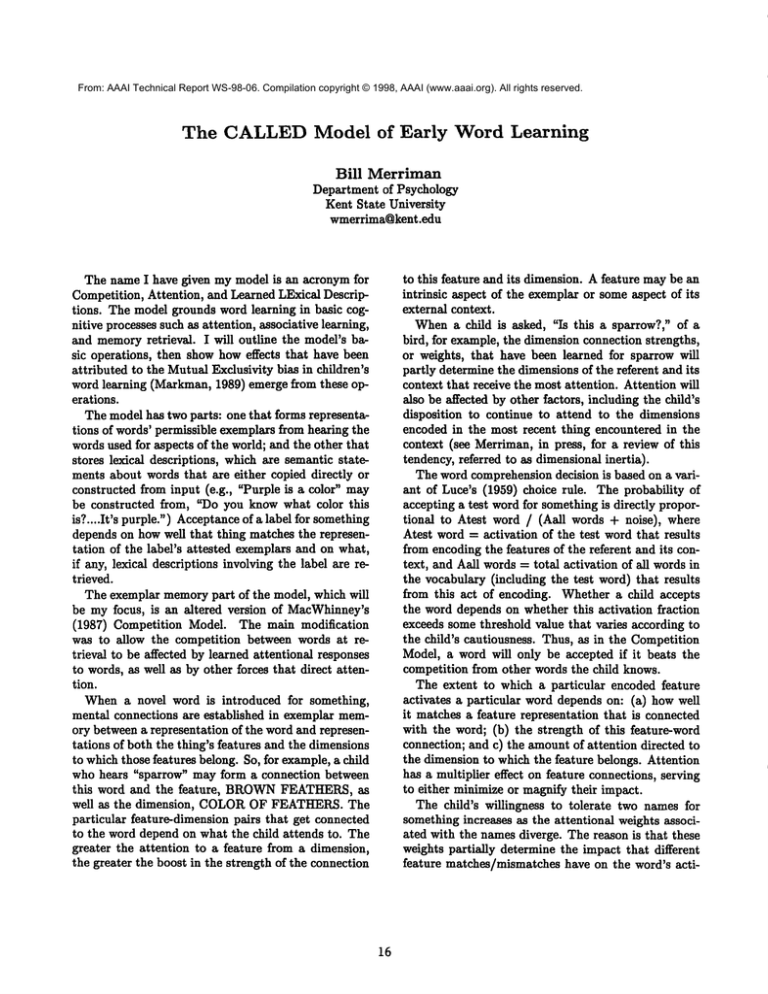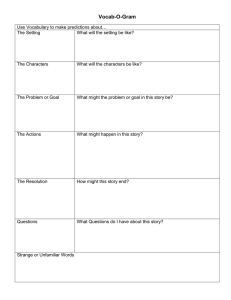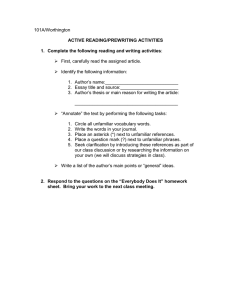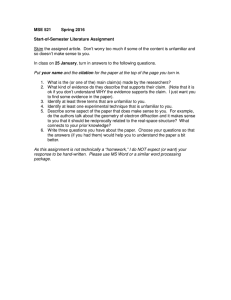
From: AAAI Technical Report WS-98-06. Compilation copyright © 1998, AAAI (www.aaai.org). All rights reserved.
The CALLEDModel of Early
Word Learning
Bill
Merriman
Department of Psychology
Kent State University
wmerrima~kent.edu
to this feature and its dimension. A feature maybe an
intrinsic aspect of the exemplar or someaspect of its
external context.
Whena child is asked, "Is this a sparrow?," of a
bird, for example, the dimension connection strengths,
or weights, that have been learned for sparrow will
partly determine the dimensions of the referent and its
context that receive the most attention. Attention will
also be affected by other factors, including the child’s
disposition to continue to attend to the dimensions
encoded in the most recent thing encountered in the
context (see Merriman, in press, for a review of this
tendency, referred to as dimensional inertia).
The word comprehension decision is based on a variant of Luce’s (1959) choice rule. The probability
accepting a test word for something is directly proportional to Atest word / (Aall words + noise), where
Atest word = activation of the test word that results
from encoding the features of the referent and its context, and Aall words = total activation of all words in
the vocabulary (including the test word) that results
from this act of encoding. Whether a child accepts
the word depends on whether this activation fraction
exceeds some threshold value that varies according to
the child’s cautiousness. Thus, as in the Competition
Model, a word will only be accepted if it beats the
competition from other words the child knows.
The extent to which a particular encoded feature
activates a particular word depends on: (a) how well
it matches a feature representation that is connected
with the word; (b) the strength of this feature-word
connection; and c) the amount of attention directed to
the dimension to which the feature belongs. Attention
has a multiplier effect on feature connections, serving
to either minimize or magnify their impact.
The child’s willingness to tolerate two names for
something increases as the attentional weights associated with the names diverge. The reason is that these
weights partially determine the impact that different
feature matches/mismatches have on the word’s acti-
The name I have given my model is an acronym for
Competition, Attention, and Learned LExical Descriptions. The model grounds word learning in basic cognitive processes such as attention, associative learning,
and memoryretrieval. I will outline the model’s basic operations, then show how effects that have been
attributed to the Mutual Exclusivity bias in children’s
word learning (Markman, 1989) emerge from these operations.
The model has two parts: one that forms representations of words’ permissible exemplars from hearing the
words used for aspects of the world; and the other that
stores lexical descriptions, which are semantic statements about words that are either copied directly or
constructed from input (e.g., "Purple is a color" may
be constructed from, "Do you know what color this
is?....It’s
purple.") Acceptanceof a label for something
depends on how well that thing matches the representation of the label’s attested exemplars and on what,
if any, lexical descriptions involving the label are retrieved.
The exemplar memorypart of the model, which will
be my focus, is an altered version of MacWhinney’s
(1987) Competition Model. The main modification
was to allow the competition between words at retrieval to be affected by learned attentional responses
to words, as well as by other forces that direct attention.
Whena novel word is introduced for something,
mental connections are established in exemplar memory between a representation of the word and representations of both the thing’s features and the dimensions
to which those features belong. So, for example, a child
who hears "sparrow" may form a connection between
this word and the feature,
BROWN
FEATHERS,as
well as the dimension, COLOROF FEATHERS.The
particular feature-dimension pairs that get connected
to the word depend on what the child attends to. The
greater the attention to a feature from a dimension,
the greater the boost in the strength of the connection
16
vation fraction. So, for example, the model would accept that a sparrow is both a bird and a sparrow if the
most heavily weighted dimensions for bird were various
shape dimensions, -t-/- has feathers, and ÷/- can fly,
but the most heavily weighted ones for sparrow were
color of features and size. The Mutual Exclusivity Bias
Despite this potential for multiple name acceptance,
the nature of the retrieval mechanismin the exemplar
memory component causes words to gravitate toward
mutual exclusive relations. The model tends to produce the three phenomena that are the primary evidence for the Mutual Exclusivity bias: (1) preferring
to map novel labels onto unfamiliar rather than familiar kinds; (2) restricting familiar label extension
response to learning second labels; and (3) learning
second labels less readily than first labels.
3. Greater Difficulty Learning Second Labels. This
effect has been documented by Liittschwager and
Markman (1994). According to CALLED,training a new label for something that is an exemplar
of another word will only succeed if the child devotes considerable attention at both training and
test to unique intrinsic or extrinsic features, ones
not strongly connected to the first label or to other
known labels. Otherwise, substantial competition
will arise from activation of these other labels at test.
References
Liittschwager,
J. C., & Markman, E. M. (1994).
Sixteen- and 24-month-olds’ use of mutual exclusivity as a default assumption in second-label learning.
Developmental Psychology, 30, 955-968.
1. Mapping Onto Unfamiliar Kinds. This phenomenon
is quite robust. Even older 1-year-olds will pick a
honey dipper over a spoon when asked, "Which one
is a zav?", for example (Mervis & Bertram, 1994).
According to CALLED,the likelihood of choosing
the unfamiliar kind is proportional to howmuchthis
object activates the novel name relative to howmuch
the familiar object activates this name. The value of
Anovel name/(Aall words % noise) for the unfamiliar kind is comparedto the value of this fraction for
the familiar kind. Even though the name is novel,
it receives some activation from each object because
there is noise in the system, and the syntactic category of the word supports assigning it to an object rather than to an attribute or action. Although
Anovel name is tiny for both objects, the denominator term, Aall words, is muchlarger for the familiar
kind than for the unfamiliar kind. Because the activation fraction for the unfamiliar kind is greater,
children select it.
Luce, R. D. (1959). Individual choice behavior. New
York: Wiley.
MacWhinney, B. (1987). The Competition Model.
B. MacWhinney(Ed.), Mechanisms of language acquisition (pp.249-308). Hillsdale, NJ: Erlbanm.
Markman, E. M. (1989). Categorization and naming
in children: Problems of induction. Cambridge, MA:
The I~T Press.
Merriman, W. E. (in press). Competition, attention, and young children’s lexical processing. In B.
MacWhinney(Ed.), The emergence of language. Hillsdale, N J: Erlbaum.
Merriman, W. E., & Stevenson, C. M. (1997). Restricting a familiar namein response to learning a new
one: Evidence for the mutual exclusivity bias in young
two-year-olds. Child Development, 68, 349-366.
Mervis, C. B., & Bertrand, J. (1994). Acquisition
the Novel Name-- Nameless Category (N3C) principle. Child Development, 65, 1646-1662.
2. Familiar Label Restriction. Youngsters sometimes
respond to hearing a second label for something by
deciding that they cannot in fact already name the
thing (see Merriman& Stevenson, 1997, for a recent
demonstration). According to CALLED,after a second label is presented, the first label has one more
competitor than it did before. The likelihood of accepting the first label for the thing should decline to
the extent that the second label is activated when
the first label is tested. If distinctive features receive
most of the attention during second label learning,
then restriction of the first label should only result
if the dimensions to which these distinctive features
belong receive attention whenthe first label is tested;
otherwise the second label will not receive muchactivation during this test.
17






